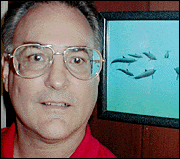Advertisement - Click to support our sponsors.


View Point
THE recent proposed Oahu-to-Maui move of the Dolphin Institute, previously the Kewalo Basin Marine Mammal Laboratory, has brought a new focus on dolphin captivity. Maui never has had captive dolphins and prides itself on having only free dolphins and whales in its waters. Dolphins head to
new prison campWhat could possibly motivate the people of Maui to justify the suffering that captive dolphins go through? This suffering and death is well documented:
These captivity issues are important when considering the Dolphin Institute's move to Maui because they show the suffering of captive dolphins and how the policy levels of the federal government ignore captivity problems in order to support those -- including the institute -- who exploit captive dolphins.Forty-seven percent of those specially selected young, healthy dolphins that survive their violent capture die within 90 days.
Wild dolphins have life spans comparable to aboriginal humans (30-45 years). Yet modern veterinary medicine and "high-tech" human medical practices (that have lengthened human life to 70-75 years) have not helped captive dolphins match the life spans of wild dolphins.
In many artificial dolphin habitats, the water is full of chemicals as well as bacteria from feces, etc., causing many health problems in captive dolphins including viruses, damaged eyes and even blindness.
When a baby dolphin is born in captivity, the news is usually kept secret until the calf shows signs of survival. Although dolphins do breed in captivity, the birth rate is not nearly as successful as the one in the wild because of high infant mortality rates.
Most wild dolphins can swim 40-100 miles per day, but in pools they go around in circles. Eight-foot long dolphins are lawfully confined in 24-by-24-foot tanks, only six feet deep. Moving to the Maui facility will be like moving from OCCC to the Halawa Correctional Facility.
Many marine parks subject their captive dolphins to hunger so they will perform for their food. Jumping through hoops, tailwalking and playing ball are trained behaviors that do not occur in the wild. Dolphins that go on strike have been subjected to reduced rations and sensory deprivation.
Captive dolphins that abuse themselves (i.e. banging their heads against the walls) are creating stimuli that their environment cannot supply. The psychology of captive dolphins is similar to abused family members unable or unwilling to escape or seek help.
Dolphins in captivity tend to develop stereotypical behaviors, like swimming in a repetitive circle pattern and in silence, because of boredom and confinement. This is equivalent to the swaying and pacing of primates, lions, tigers and bears confined in small cages.
The Dolphin Institute has broadcast that it wants to perform two-way communication with the dolphins at the Maui facility in order to justify the move. Considering that Kewalo Basin laboratory has published papers adamantly opposed to doing two-way communication with dolphins, this is an interesting development.
The last time the laboratory pushed two-way communication with dolphins was in 1976, after it lost its National Science Foundation funding due to a blunder at the highest level. Problems resulting from this lack of funding led directly to the deterioration of the Kewalo dolphin facility to unacceptable levels and, eventually, the release of the lab dolphins by all of the lab residents and other students and teachers in 1977.
Two-way communication with dolphins is very popular and of great use when trying to overcome obstacles like loss of National Science Foundation funding or moving dolphins where people do not want them to be moved.
However, pioneer researcher Dwight "Wayne" Batteau already established two-way communication with dolphins in 1967 for the U.S. Navy. The Navy classified its dolphin program when Batteau mysteriously washed up dead on the beach in Waimanalo and then "sanitized" all evidence of his program except the papers.
TODAY, old nuclear submarines are modified and new submarines are built around talking dolphins and their S.E.A.L. teams.
When the Kewalo Basin laboratory began replicating Batteau's work in the mid-1980s, the Navy stepped in and began funding research at the University of Hawaii lab, which almost immediately stopped all work on two-way communication with the dolphins.
This change of direction did not escape others. Cutting-edge animal language researchers like Sue Savage-Rumbaugh and David Premack criticized this change in direction.
But, the Kewalo Basin laboratory -- not the Dolphin Institute -- held firm until now. Is this a real change in direction or a hollow ploy to get the move approved?
It is important to remember that the Dolphin Institute is a lab run by psychologists. In such an environment would captive dolphins ever be allowed to ask for their freedom to go home?
Ken LeVasseur, who has a degree in species communication from the University of Hawaii, has been studying dolphins for more than 25 years. He was one of two men convicted of first-degree theft for releasing two dolphins from the Kewalo Basin laboratory in May 1977. He was sentenced to six months in jail and probation. The jail sentence was subsequently suspended. Instead he was required to perform 400 hours of community service.